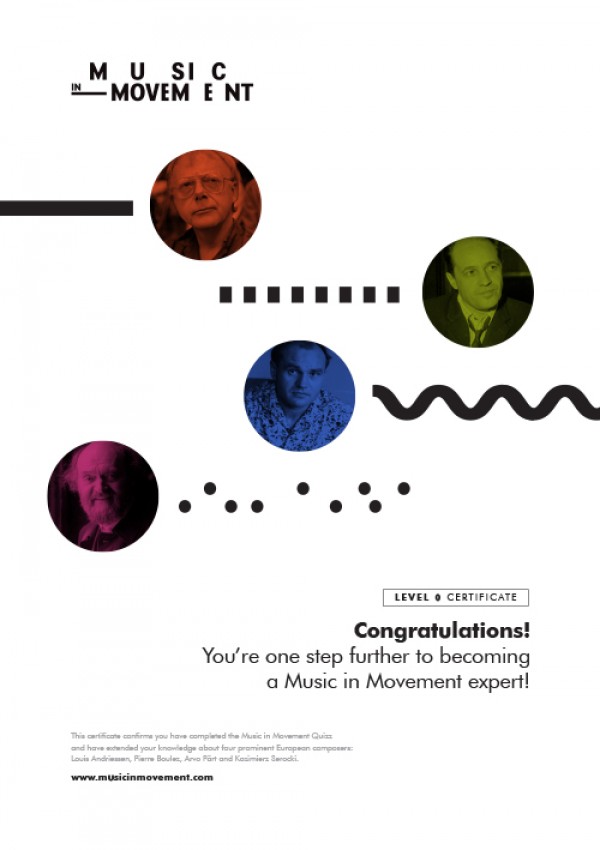MiM quiz – Explorer level / Education
Remember, this quiz is not about testing your knowledge about contemporary music. It's all about getting to know the four composers - their music, techniques, but also inspirations and private stories. We invite you to take on this challenge - discover the universe of four personalities and dive in into their music.
Orchestral music - who composed this musical piece?
Listen to the short excerpt and recognize the composer.
Instrumental color scheme also plays a major role in Pli selon pli composed by Pierre Boulez, but this piece sounds quite different from Serocki’s music. Boulez saw the precise pitch as equally important as harmony arrangements.
In Ad libitum the nature of the music resembles that of colour fantasia, like in many of Krzysztof Serocki’s works.
A vivid, though by no means simple rhythm, sound of the orchestra favouring the brass rather than the strings suggest Louis Andriessen – the example is taken from his Mysterien.
Consonant chords, melody and harmony bringing to mind Renaissance music in Arvo Pärt’s 3. Symphony are characteristics of many of his works.
Chamber music - which of the four composers wrote this musical piece?
Listen to the short exceprt and recognise the composer.
The example comes from Louis Andriessen Zilver.
The example comes from Kazimierz Serocki Swinging Music.
The example comes from Arvo Pärt – Es sang vor langen Jahren.
The example comes from Pierre Boulez – Le marteau sans maître.
Which composers visited the International Summer Course for New Music in Darmstadt?
Since 1946 the International Summer Course for New Music in Darmstadt has been the most important meeting place for composers interested in new phenomena in music. For two of the Four Composers the Darmstadt course was an important place in their artistic biographies, for the remaining two – not at all. Which composers visited the course?
In 1958 Musica concertante (1958) by Kazimierz Serocki was the first ever piece by a Polish composer to be premiered during the Internationale Ferienkurse für Neue Musik in Darmstadt. In the 1950s PB, Karlheinz Stockhausen and Luigi Nono were considered to be leading young avant-garde composers, for whom the Summer Course in Darmstadt remained for a while the most important forum for presenting their own music and concepts.
Vocal music - who composed this musical piece?
Listen to the short excerpt and recognize the composer.
The example comes from Pierre Boulez – Pli selon pli.
The example comes from Louis Andriessen La passione.
The example comes from Arvo Pärt – Kanon pokajanen.
The example comes from Kazimierz Serocki Poesies.
Which of the composers is associated with the concept of tintinnabuli?
Arvo Pärt invented his personal musical language in 1976 after discarding all modernist tools and studing early polyphony and Gregorian chant for many years. He named it tintinnabuli – from Latin tintinnabulum meaning ’little bell’.
Read more about tintinnabuli.
Scandals are part of the history of 20th-century music (in the 21st century scandals are not so easy to come by). Three of our four composers became protagonists of scandals for reasons listed below. Which composer is concerned in each case?
In 1945, in Paris Pierre Boulez with a group of young composer’s from Olivier Messiaen’s class organized a “charivari” during a performance of a neoclassical piece by Igor Stravinsky. For the young followers of dodecaphony the Russian composer was at that time an embodiment of regressive tendencies in music.
In 1969, in Amsterdam’s Concertgebouw young composers, with Louis Andriessen among them, sought to prevent Bernard Haitink from beginning a concert, protesting against the “undemocratic structure of the Concertgebouw Orchestra” and the lack of innovative contemporary works in its programmes
In 1968 Arvo Pärt’s Credo was performed in Tallinn – the piece featured the words “Credo in Jesum Christum” (I believe in Jesus Christ). The religious content of the piece outraged the Soviet authorities, as a result of which Pärt’s works were subsequently eliminated from the official concert repertoire and from the radio.
Well done!
We hope you enjoyed the experience!
You can now share & save your MiM certificate!

